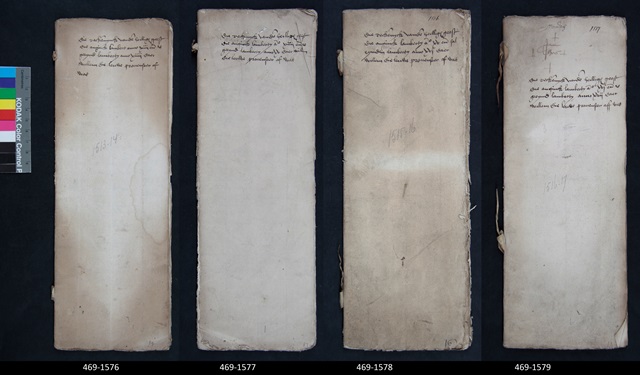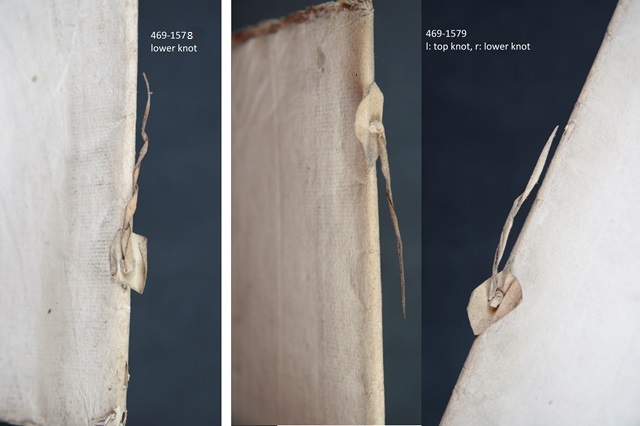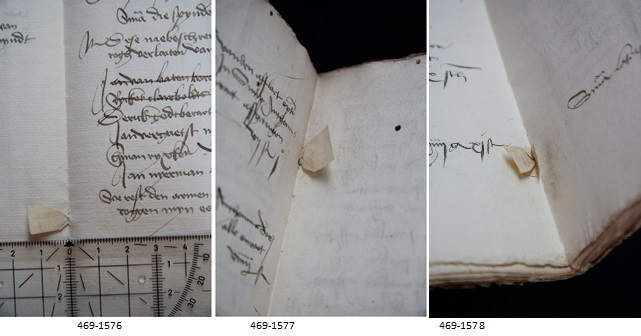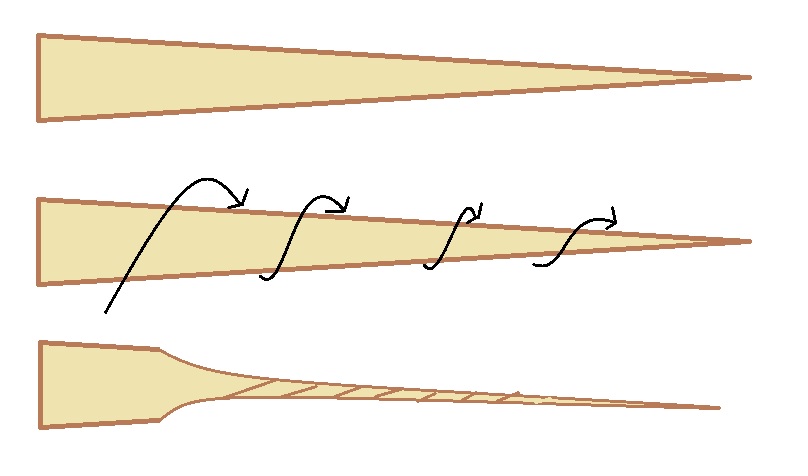Searching through the medieval archives of my hometown Nijmegen, I found four little booklets with the most simple type of binding I ever saw. Just a scrap of parchment and one knot. Time to zoom in on these books.
The Regionaal Archief Nijmegen (RAN) houses, among others, the archive of the Nijmeegse Broederschappen (confraternity) from 1330 till 1965. It’s called archive 469. In this archive I found 7 booklets1 containing the ‘Rekeningen van de Heilige Geest Broederschap’ (accounts of the Holy Spirit confraternity), of which 4 had a special type of binding. The others had twisted parchment tacketed bindings, standard fort his archive. These are the 4:
| nr | Content | year | written by |
| 469-1576 | Rekeningen van de H. Geest Broederschap | 1514 | Auginck Lamberty |
| 469-1577 | Rekeningen van de H. Geest Broederschap | 1515 | Auginck Lamberty |
| 469-1578 | Rekeningen van de H. Geest Broederschap | 1516 | Auginck Lamberty |
| 469-1579 | Rekeningen van de H. Geest Broederschap | 1517 | Auginck Lamberty |

These 4 booklets consist of just 1 quire of paper, and the cover is of the same material. It’s just a blank double folio. The size is a high quarto, 10 x 30 cm. It is, for RAN, a really common size for these year-accounts of the small confraternity’s. Most of them are bound together by 2 twisted parchment tackets, but not here. Here they are bound by… well… I really don’t know how to call it. A parchment knot?
A parchment knot
All 4 booklets have, on the spine, 2 small parchment knots. 1576 and 1577 only have the knot, where 1578 and 1579 also still have the ‘tail’ of the parchment strip.
Also on the spine reinforcements are visible; all 4 have a (really) small piece of parchment between the knot and the paper, a kind of ‘stay’ but at the outside.


With only this one knot at the outside, you start wondering what is going on in the heart of the quire. At the inside we find the other side of the parchment and it is just a straight and much broader piece of parchment, some with a stay.


in 1578 a stay.
This was the most minimalistic type of attachment I ever encountered. Looking closely, it became clear that it was made with a small pennant of parchment. The thinner part has been wetted and twisted, so a sort of cord was made. This cord was pulled through the sewing hole, leaving the broader, not twisted part on the inside at the heart of the quire. At the spine they made a small knot in the cord, flat against the spine. And done, booklet secured!

| nr | stay in the heart | stay at the spine | knot / knot with tail |
| 469-1576 | no | yes | knot |
| 469-1577 | no | yes | knot |
| 469-1578 | yes | yes | 1 knot with tail, 1 knot |
| 469-1579 | yes | yes | knot with tail |
Tail or not
The biggest difference between these 4 booklets are the knots on the spine. 2 booklets (1576 and 1577) have only 2 small knots at the spine, 1 booklet (1578) has 1 knot and 1 knot with tail and 1 booklet (1579) has 2 knots with tail. Is this intentional?
The tails are intentional, I am sure, otherwise you just cut them off. But are the ones without tails intentional, as in the tails were cut off, or are the tails just broken after 500 years? My guess is that the booklets 1576 and 1577 have intentionally cut off knots and that 1578 has a broken tail. Why?
As I said, parchment twisted tackets are common. They differ in the way the ends are finished. Stuck through the holes inside the book, just left outside as small tails or cut off. All occur, but each book has just one method. Books with different ways of tacket-finishing are rare. This makes me think that this booklet 1578 had two similar tails, and one broke off. Although it could be possible that 1576 and 1577 have broken tails also, I don’t think life was hard enough for them to have these injuries. The booklets are in very fine condition so the possibility that not 1 but 5 tails were broken is very small.
Who bound them?
Simple bindings occur a lot in archives. In The Netherlands the parchment twisted tacket is present in overwhelming amounts. But this little knot, consisting of a scrap of parchment, is the most minimalistic binding I have ever encountered. And I have only seen it on these 4 booklets.2
Although the bigger administration books in the city of Nijmegen were bound by a bookbinder, these tiny booklets were bound by the writer. This is underlined by the fact that these four booklets were written by the same man, Auginck Lamberty, and that the other booklets in the series are written by another man (Willem Floriss) and all have another binding. If they would give the quire to a friar who would bind the booklets every year, this type of binding would be the same for a longer period.
Why Auginck Lamberty chose for this little knot instead of the common parchment twisted tacket will never be clear. Maybe he didn’t have enough bigger parchment scraps lying around to make a tacket so he just played around with the tiny pieces he had. But I am really happy I encountered his four booklets and that Auginck showed me this incredible minimalistic binding.
Footnotes
- At the time, I was presented with those 7 as ‘the ones with a medieval binding’. A later search through the database showed me much more booklets in this series, but until today I was not able to visit the archive to have a look at those others due to invalidity.
- As explained in footnote 1, I was under the impression that there were only 7 booklets to be studied and of those there were 4 booklets with this binding method. Checking the other ones will be a future project.

Leave a comment